On the third day, we got on a coach and took the 6 hour journey from Siem Reap to the capital city, Phomn Penh. Along the way (and rather in the middle of nowhere) we saw a young boy walking along the deserted stretch of long dusty road carrying bags full of goods he was probably on his way to sell. Boy got knocked down by a passing motorcycle and immediately started bleeding. The coach didn't stop and I was plagued with a sense of sadness and worry, and only after we travelled for another good twenty minutes before we passed an ambulance probably headed back to help him. Super tragic, and really reminds me to appreciate how good we locals have it in Singapore.
At the rest stop, we saw lots of locals selling creepy crawlies, and I'm not talking about regular creepy crawlies. The minute we got off the coach, we were approached with this girl who looked like she had a spider brooch the size of my palm on her chest. Turned out to be real (it didn't move at all till she touched it!!!) and we totally freaked. That's Viv and her mom with a lotus plant.. the seeds can actually be eaten just like that!
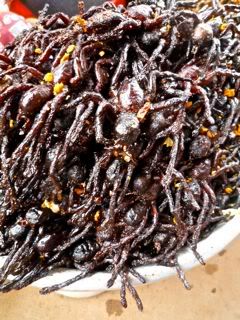
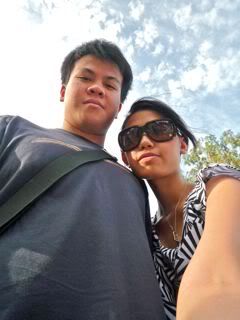
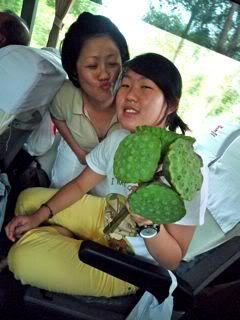
A bit of history: The Cambodian Genocide was brought about by Pol Pot, who was educated in France then returned to Cambodia and came into power upon the fall of Phnom Penh in 1965. He then served as the Prime Minister from 1966 to 1968.
During the two years of his (psychotic) reign, Pol Pot ruthlessly murdered more than TWO MILLION of his people.
Upon arrival in Phnom Penh, we had a quick lunch before visiting the Choeung Ek Genocidal Center. which actually used to be one of the many killing fields. About 15,000 of the 2 million+ victims were believe to be massacred here. It was a genuinely spine-chilling and depressing experience to have visited the killing fields.
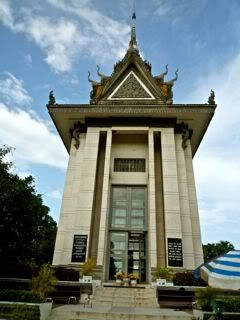

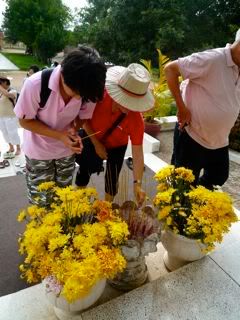
In a tall glass case rests the bones and skulls of more than 8000 victims. Pictured below are some of the skulls belonging to " "Juvenile female Kampuchean from 15 to 20 years old".
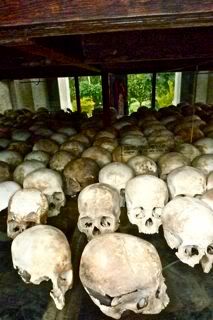
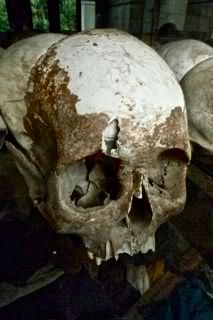
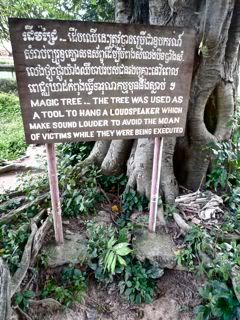
The tree shown below is the actual killing tree which Pol Pot's army would use to kill children by picking them up by their feet and repeatedly swinging/hitting them on the tree until they bled and died ):
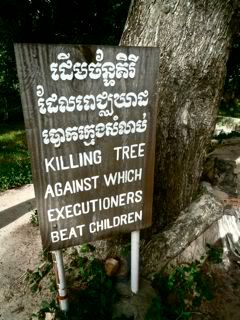
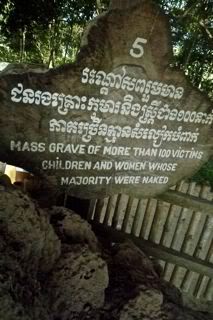
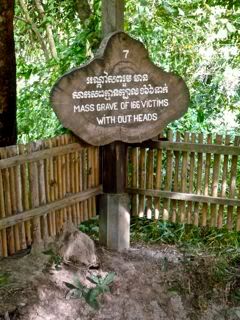
Just 10 years ago, Cambodia had not even begun clearing up the killing fields and tourists who visited the place would be immediately overwhelmed by the stench of dead bodies which were either carelessly lain on the ground or buried under overgrowth. Apparently, the stench was so foul that many tourists would faint before even entering the grounds. Today, they have begun to clean up the area, and as you see, they've transformed bits of the area into a memorial or mass graves for the victims. However, the damage was just too devastating and extensive, and the water you see in the background of the pictures were all actually once killing fields and the bodies in those areas have yet to be cleared as apparently, the government just does not have the capacity to deal with it yet. I think it extremely sad that all those victims have yet to be given the proper respect and resting grounds that they deserve. Sadder still is that today's youth of Cambodia have to resort to playing in the killing fields barefoot, wandering around the muddy death-water begging for money behind the barb wires, almost as though they are animals behind a cage in the zoo ):
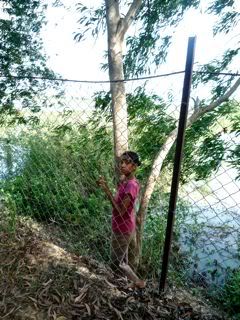
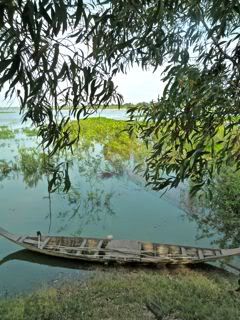
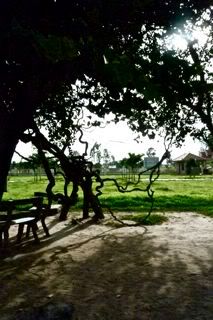
Day 4
Visited the "Wat Phnom" in the morning. Basically, the name means temple on a hill. The myth behind this temple is that a Cambodian woman was around the riverside when she spotted four Buddhas floating around her. She then brought them over to this hill, where a temple was built to house them.
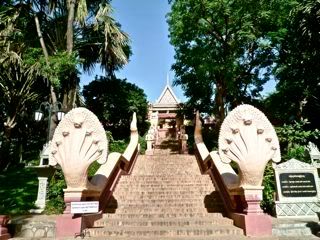
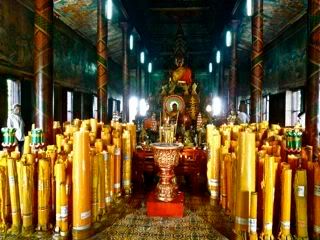
Tom, Viv, Daren & I standing in front of the giant clock on the hill, which was a present from China to Cambodia. The clock is apparently worth 90,000 US dollars, and whilst I suppose the gesture is kind of sweet and I'm sure much appreciated, I personally think that 90,000$ could have gone to a much more humanitarian cause. Do the citizens of Cambodia really need a giant clock when the vast majorities can barely afford homes, education, healthcare or even food and clean water?
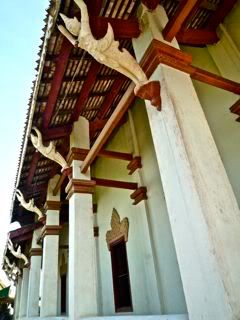
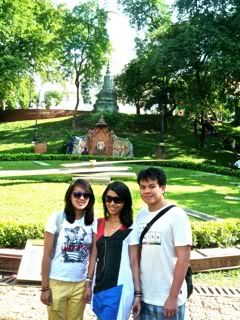

We then made our way over to the Royal Palace, built in 1886 and served as the King's residence. The palace grounds were largely completed before WW1 and the Thais and French contributed heavily. In fact, Napoleon (the then King of France) demanded that a house be built specifically for him on the royal grounds, for when he came to visit. Unfortunately, he passed away before visiting Cambodia. The iron house engraved with his name on the door still stands today. Behind us in the photo is the throne hall where all the kings of Cambodia have been coronated .
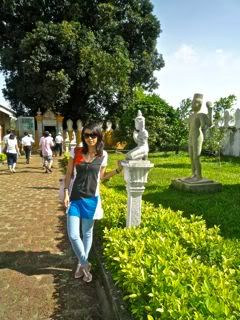
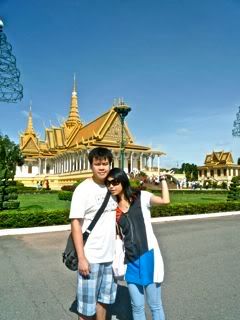
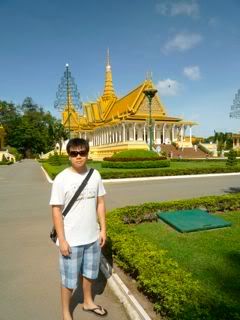
The concubines have 7 different colored dresses for the 7 days in each week. One of the interesting things I learnt is that in her time, Cambodia was one of the richest countries in the world. Everything in the palace was made of gold, from ornaments to cutlery, temples and furniture, even the power sockets in the wall were made of gold. However, after a French diplomat noticed this and commented on it, the Cambodian royals decided to paint everything over with a coat of red paint so as not to give the image of being overly wealthy or arrogant, as well as to deter aggression. Today, even though the red paint has been removed, a reddish tint can still be seen on the gold.
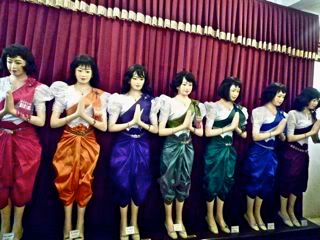
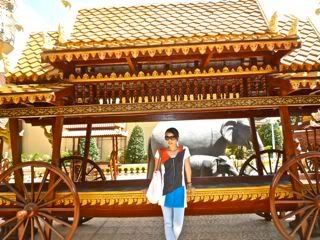
After lunch, we visited the Tuol Sleng Genocide Museum, which is a high school that Paul Pot and his army transformed into a prison called the S.21 (Security office 21). The classrooms on the ground and first floors were divided into individual prison cells whilst the higher floors were used for mass detention.
Thousands and thousands of victims were imprisoned here before being exterminated in front of their wives or children. Pol Pot's prisoners included workers, technicians, engineers, doctors, teachers, students, monks, minister, foreigners and even his own soldiers. After each of his victims was killed, Pol Pot regulated that his soldiers must take a picture of them dying or dead to prove that they had indeed been killed, otherwise the soldier would be punished. The compilation below is a collection of gruesome pictures of some of the victims. The list of "security of regulations" include "while getting lashes or electrification you must not cry at all"

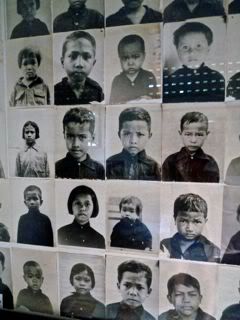
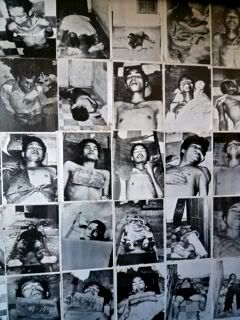
This exercise poles used by high school students got transformed into a torture method during the Khmer rouge. The interrogators tied both hands of the prisoners to the back by a rope and lift the prisoners upside down hanging on the pole until they lost consciousness. They would then dip the prisoners head into a jar of smelly filthy fertilizer or manure to wake them up before resuming their interrogation and hanging them upside down. Blood stains can still be seen on the walls of the prison today.
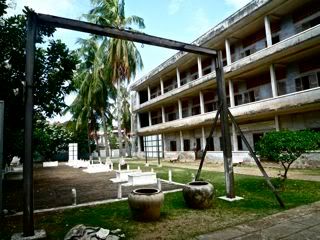
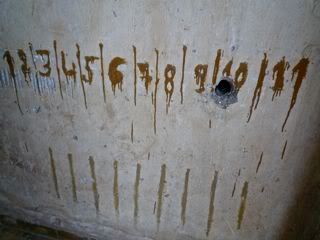
The actual electric chair used to kill prisoners is displayed in the Genocide Museum today. Instead of just electrifying the victims, Pol Pot preferred to torture them with a slow, painful death. The chair features an electric drill which would penetrate into the victim's skull while he or she was fully alive and aware, and then be left to slowly die. The skulls that remain in the museum have evidences of the holes made by the electric drills. Often, mothers were instructed to be executed in the electric drill chair with their babies alive in their hands. Only after their deaths would the babies be killed.
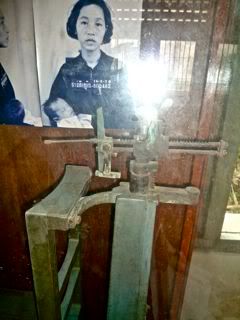
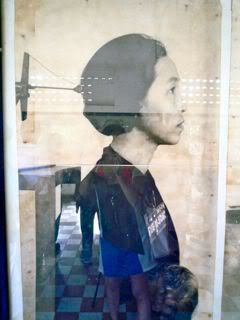
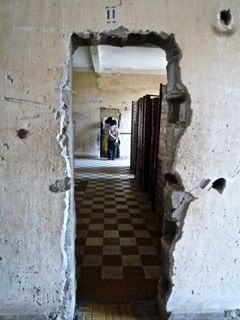
After that harrowing experience, we lightened up by visiting the casino, but no pictures were allowed. There we had our only good meal in Cambodia at a Korean Restaurant... Full bento meal with unlimited supply of the cold dishes like Kim Chi etc, and only $8 per person. I guess in general we didn't really enjoy Cambodian food, it was okay but nothing to rave about. We thought it was much like Thai or Vietnamese food, just blander, and without the burst of flavour.
The Independence Monument was built in 1958 as a memorial to the war victims as well as to celebrate the independence of their country from france. Their building features five tiers decorated with 100 snake heads.
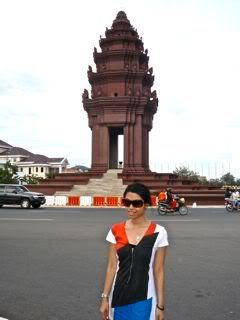
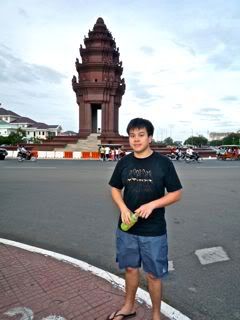

After dinner, we took a TUK TUK for the first time in my life. It was craaazy, especially when the driver turned out into a two way road and was driving right into oncoming traffic! Crazy but actually pretty fun.
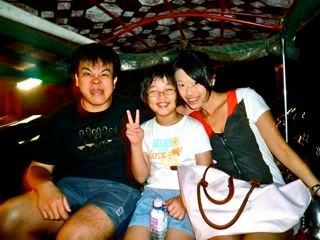
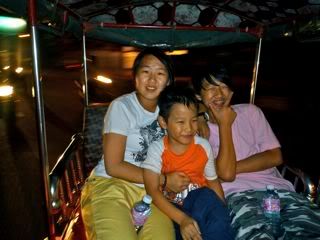
Spent awhile walking around the night market. I think Cambodians are not as well versed in the art of haggling, the way the Thais are. Once we walked away they would give us any price we wanted at all. Daren and Tom got tee shirts for cheaper than $1 and I got a watch at $4.... Crazy.
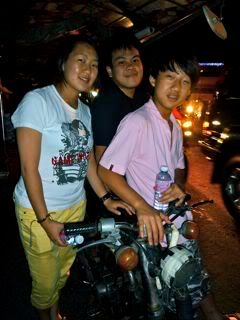
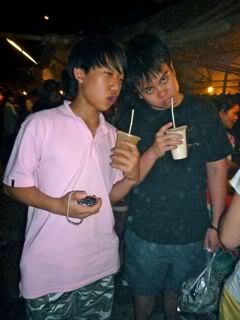
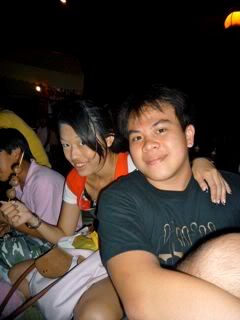
After a long day, the boy & I headed back to our room for a massage (I think the two masseuse who came to our room expected only guys, as they were dressed super sleazy and had very heavy make up, and seemed kind of upset....) Anyhow, after they left, we started playing with our Nintendo DS (we are tetris freaks, I know, geeks!!!!) when the room suddenly went black. We couldn't even use the phone to call down to reception and we were the only room with the problem I think, so Daren ran downstairs to get the receptionist who then informed us we would have to wait for a technician to come and it would take about half an hour. Quite funny because it didn't affect us much, as we were playing our DS the entire time we waited and even whilst the technician was in our room trying to fix the problem HAHA.
Day 5
Lazy day cruising down a river (i don't remember the name, haha)

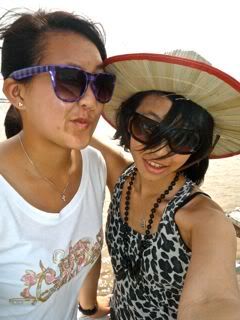
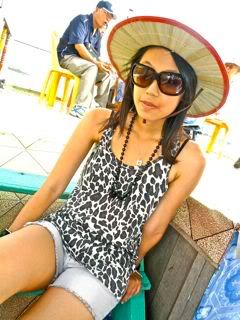
I ♥ my straw hat!


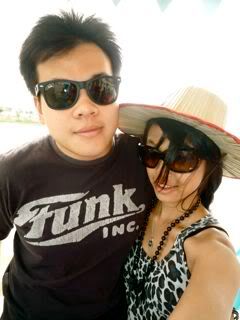
The little ones
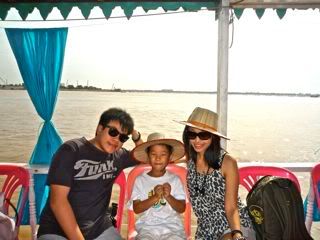
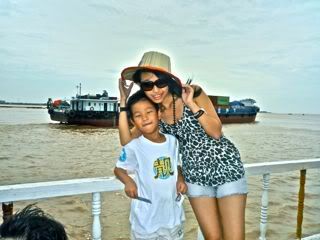
Group shot :)
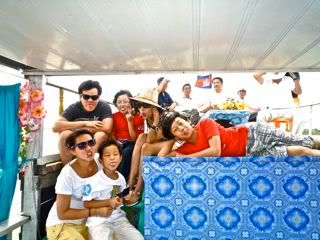
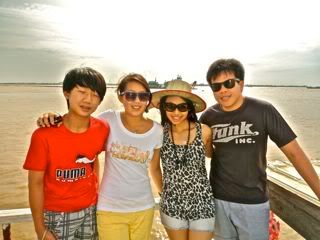
Tom's a retard -_-
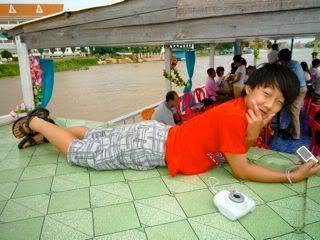
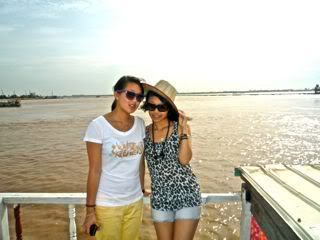
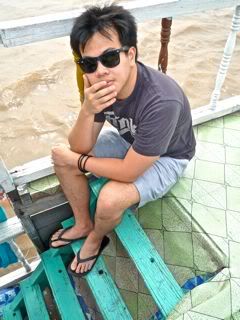
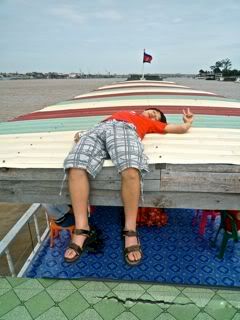
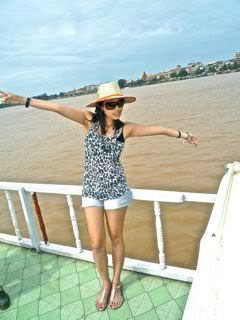
In retrospect, I would actually say that this is definitely one of the top 3 trips I have ever made in my life. I've never experienced anything quite like it, I learned so much and it was such a good reminder of how lucky we are, of how I want to help contribute to a better world. It was truly an eye opener indeed. The children there, staring up at you with desperation in their eyes. All of them so bright, if only they were given a chance. If they can be speaking in all sorts of languages and understanding the knowledge of bargaining at such young ages.... it's just a testament to their potential, only a pity that their streets smarts have to be brought about only because they have no other choice, no other way of life. The way they were so satisfied when I gave them cookies or shoes, and even though I know that 30 packets of cookies or 15 pairs of sandals are really going to make very little difference in their lives, I guess for me, I just want them to know that life isn't all that bad and to believe in hope and always have faith. We all need hope and faith in our lives to see us through. I would definitely want to go back to Cambodia in the future, and not just as a tourist. This country, with all it's paradoxical sadness and potential has captured my heart.
No comments:
Post a Comment